Gestern habe ich durch Zufall etwas gelesen, was in mir den Plan reifen lässt, mal wieder nach Rom zu fahren.
Nein.
Es hat nichts mit aufgehobenen Corona Richtlinien zu tun.
Nein.
Es steht auch kein Spiel in irgendeinem europäischen Fußballwettbewerb ein.
Nein.
Es ist auch keine neue Papstwahl in Aussicht.
Aber für mich persönlich bekommt der Besuch der ewigen Stadt ein Reiseziel zurück, das einigen von Ihnen vielleicht gar nicht bekannt ist.
Seit 2014 ist das Museo della Civiltà Romana wegen aufwendigen Renovierungsarbeiten geschlossen; na und jetzt habe ich gelesen, dass ich mich wieder auf die Lauer legen muss.
Vielleicht öffnet es sogar 2022, vielleicht auch erst im nächsten Jahr.
Aber es öffnet.
Und ja.
Das ist für mich ein echter Reisegrund.
Wenn Sie das Museum nicht kennen sollten, ein paar Bemerkungen dazu.
Ich war 1981 zum ersten Mal in Rom. Mit unserem Latein Leistungskurs.
„WELCH GROßARTIGE STUDIENREISE“, ruft heute noch der ergraute Teilnehmer der damaligen Exkursion aus
Der erste Grund: Meine gleichaltrige Freundin war mit dabei; und es war sehr heiß in diesem Sommer.
Der zweite Grund: Da ich ja über beide Ohren verliebt war, konnte auch die Stadt auf mich wirken. Ich musste mich ja nicht ablenken lassen, weil die Ablenkung an meiner Seite ging, und mir – jedenfalls damals – noch sicher war.
Ich musste mich folglich nicht nach dem Dolce Vita umschauen, sondern konnte den Rest meiner Gedanken und Gefühle komplett auf die Stadt lenken, und ja, ich gestehe es, Rom hatte mich in nur wenigen Stunden gänzlich in seinen Bann gezogen.
Der Lebensstil, die Lebensfreude, die Architektur, der Mix von Antike, Barock und Moderne, alles das habe ich in solch einer speziellen Mixtur in keiner anderen Stadt erlebt.
Rom hatte mich gefangen.
Ich hatte das Gefühl, ich bin mit dieser Stadt eins.
Am Ende der Reise kaufte ich mir dann ein Buch:
Das Rom der Cäsaren.
In diesem Buch waren hochauflösende Bilder eines Stadtmodells des antiken Roms.
Die Bilder waren so beeindruckend, dass ich noch Jahre nach dem Besuch der Stadt den Bildband immer wieder einmal in die Hand nahm, um darin zu blättern.
Sie prägten definitiv mein Verständnis von Aufbau und Architektur des kaiserlichen Roms.
Als ich dann Jahrzehnte später erneut nach Rom fuhr, gab es dann schon andere Möglichkeiten der Recherche als in den 80er Jahren.
Und natürlich nahm ich das alte Buch in die Hand – das, nebenbei bemerkt, immer noch völlig neu wirkt, weil ich es schon in einer gewissen Art und Weise als meinen eigenen Schatz betrachtete, und somit auch immer pfleglich behandelt habe.
Na und da las ich dann das erste Mal bewusst woher diese tollen Bilder stammten, die mich jetzt schon mehrere Jahrzehnte begleitet hatten.
Sie sind Fotografien eines echten Dioramas im Maßstab 1:250 des antiken Roms in konstantinischer Zeit.
Ausgestellt im Museo della Civiltà Romana in Rom.
Dieses Modell wurde von Italo Gismondi im Jahr 1933 begonnen, 1937 auf der Mostra Augustea della romanità – einer Ausstellung zur Zeit des Faschismus in Italien – zum ersten Mal der Öffentlichkeit gezeigt. Zu diesem Zeitpunkt war das Stadtzentrum Roms im Modell bereits fertiggestellt.
Es war geplant, dass dieses Modell auch in einem zu bauenden Museum zur römischen Geschichte und Kultur ausgestellt werden sollte.
Dieses sollte zur Weltausstellung 1942 fertig werden.
Allerdings fand diese Weltausstellung aufgrund des Zweiten Weltkriegs nicht statt.
Das Bauprojekt wurde aber nicht aufgegeben, sondern in den 50er Jahren abgeschlossen und so fand das Modell auch seinen Weg in dieses neue Museum, eben in das Museo della Civiltà Romana,
1955 war dann das gesamte Stadtgebiet Roms innerhalb der Aurelianischen Mauer als Modell fertig.
Interessant ist, dass bis zum Lebensende Gismondis im Jahr 1974 das Modell immer wieder aktualisiert wurde. Neueste Forschungen und Erkenntnisse der Archäologie wurden somit laufend berücksichtigt.
Dieses Modell ist eines der Highlights in diesem Museum.
Das Großdiorama betrachten sie aus der Höhe.
Eine umlaufende Galerie ermöglicht Ihnen die Betrachtung des Werks von allen Seiten.
Ein weiteres Highlight ist der komplette Gipsabdruck der Trajanssäule, der in Einzelsegmenten in einem Raum ausgestellt ist.
Natürlich ist es ein Erlebnis die Trajanssäule im Original auf dem Trajansforum zu sehen.
Aber Details der einzelnen Reliefs sind natürlich viel einfacher hier an dieser vollständigen Kopie zu erkennen.
An der Originalsäule müssten Sie dann schon mit einem Fernglas oder dem Objektiv einer Kamera arbeiten.
Hier schreiten sie in Augenhöhe an den Reliefs entlang.
Natürlich ist die Entstehung des Museums in seinen Grundzügen belastet.
Ursprünglich sollte es zur Verherrlichung des italienischen Königtums und dann später des italienischen Faschismus dienen.
Bereits 1911 war Ausstellung ins Leben gerufen worden für die spezielle Exponate, Kopien, Abgüsse etc. gefertigt wurden, die die Grundlage des heutigen Museums darstellen.
Diese Ausstellung wurde erweitert, und fand dann 1929 im Museo dell’Impero Romano ihren ersten Ausstellungsort. Der nächste Stepp der Erweiterung war die bereits oben erwähnte Ausstellung Mostra Augustea della romanità im Jahr 1937.
Gerade die Erweiterungen aus der faschistischen Zeit hatten einen bestimmten ideologischen, propagandistischen Anspruch.
Der Faschismus sollte als direkter Nachfolger und Vollender des alten römischen Imperiums in Szene gesetzt werden. Es wurde eine direkte Linie vom Imperium Romanum zu Mussolinis „Imperium“ gezogen.
Absolut vermessen, absolut größenwahnsinnig.
Von diesem Charakter ist das Museum heute gänzlich befreit. Es ist halt nur in den Räumlichkeiten zu finden, deren Planung bereits auf die 30er Jahre zurückgehen; und ja. Man sieht diesem Stadtbezirk natürlich an, dass hier die faschistische Architektur der 30er Jahre quasi formvollendet dargestellt wurde.
Ich persönlich würde den Besuch des Museums jedem Modellbauer als Beginn einer Romreise empfehlen.
Man bekommt tatsächlich einen sehr schönen Überblick über die Geschichte mit interessanten Exponaten, auch wenn es, wie jetzt bereits mehrfach geschrieben, Kopien bedeutender Originale sind.
Viele Themen sind durch Modelle dargestellt.
Modelle, die obwohl aus dem frühen letzten Jahrhundert stammend immer noch aktuell sind.
Vielen Besuchern werden diese Modelle helfen, die „Ruinen und Steine“, die sie beispielsweise auf den Kaiserforen oder dem Forum Romanum dann vorfinden werden, besser zu verstehen.
Nicht jeder hat da die Fähigkeit sich den Originalzustand vorstellen zu können.
Just zu diesem Zweck sind einstmals Modelle geschaffen worden, und die finden sie in diesem Museum.
Mein Rombesuch ist ja jetzt auch schon wieder Jahre her, und ich muss sagen, dass meine damalige Kamera in der Auflösung schlechter war als mein heutiges Handy.
Trotzdem konnte ich ein paar Fotos schießen, die auch heute noch brauchbar sind.
Diese sehen Sie in diesem Bericht.
Ich denke aber, dass diese definitiv aufgefrischt werden könnten, müssten.
Also mal schauen, ob nicht bald doch die Gelegenheit kommt.
Ich freue mich jedenfalls schon darauf.
No
It has nothing to do with canceled Corona guidelines.
No
There is also no game in any European football competition.
No
There is also no prospect of a new papal election.
But for me personally, visiting the Eternal City brings back a destination that some of you might not even be aware of.
Since 2014, the Museo della Civiltà Romana has been closed for extensive renovations; well and now I've read that I have to watch.
Maybe it will even open in 2022, maybe next year.
But it opens.
And yes.
This is a real reason for me to travel.
If you are not familiar with the museum, a few comments.
I was in Rome for the first time in 1981. With our Latin high-school course.
"WHAT GREAT STUDY JOURNEY", exclaims the grey-haired participant of that excursion
The first reason: my girlfriend of the same age was there; and it was very hot that summer.
The second reason: Since I was madly in love, the city was able to have an effect on me. I didn't have to let myself be distracted, because the distraction went to my side and I - at least back then - was still safe.
As a result, I didn't have to look around for the Dolce Vita, but was able to direct the rest of my thoughts and feelings completely towards the city, and yes, I confess, Rome had me completely under its spell in just a few hours.
The lifestyle, the joie de vivre, the architecture, the mix of antiquity, baroque and modernity, I have not experienced all of this in such a special mixture in any other city.
Rome caught me.
I felt like I was one with this city.
At the end of the trip I bought a book:
The Rome of the Caesars.
In this book were high-resolution images of a city model of ancient Rome.
The pictures were so impressive that, years after visiting the city, I kept picking up the illustrated book to leaf through it.
They definitely shaped my understanding of the layout and architecture of Imperial Rome.
When, decades later, I went to Rome again, there were other research options than in the 1980s.
And of course I picked up the old book – which, by the way, still looks completely new because I already considered it my own treasure in a certain way, and have therefore always treated it with care.
Well and then I read for the first time consciously where these great photos came from, which had accompanied me for several decades.
They are photographs of a real 1:250 scale diorama of ancient Rome in Constantinian times.
Exhibited in the Museo della Civiltà Romana in Rome.
This model, begun by Italo Gismondi in 1933, was shown to the public for the first time in 1937 at the Mostra Augustea della romanità - an exhibition held at the time of Fascism in Italy. At this point, the city center of Rome was already completed in the model.
It was planned that this model should also be exhibited in a museum of Roman history and culture that was to be built.
This should be ready for the 1942 World Exhibition.
However, this world exhibition did not take place due to the Second World War.
However, the construction project was not abandoned, but completed in the 1950s and so the model found its way into this new museum, the Museo della Civiltà Romana,
In 1955 the entire urban area of Rome within the Aurelian Walls was finished as a model.
It is interesting that until the end of Gismondi's life in 1974, the model was repeatedly updated. The latest research and findings in archeology were thus continuously taken into account.
This model is one of the highlights in this museum.
You look at the large diorama from above.
A surrounding gallery allows you to view the work from all sides.
Another highlight is the complete plaster cast of Trajan's Column, which is exhibited in individual segments in one room.
Of course, it is an experience to see the Trajan's Column in the original on the Trajan's Forum.
But details of the individual reliefs are of course much easier to recognize here on this complete copy.
You would then have to work with binoculars or the lens of a camera on the original column.
Here you walk along the reliefs at eye level.
Of course, the creation of the museum is burdened in its basic features.
Originally it was intended to glorify Italian royalty and then later Italian fascism.
As early as 1911, an exhibition was created for which special exhibits, copies, casts, etc. were made, which form the basis of today's museum.
This exhibition was expanded and then found its first exhibition space in 1929 in the Museo dell'Impero Romano. The next step in the expansion was the exhibition Mostra Augustea della romanità in 1937, already mentioned above.
Especially the extensions from the fascist period had a certain ideological, propagandistic claim.
Fascism was to be staged as the direct successor and finisher of the ancient Roman Empire.
A direct line was drawn from the Roman Empire to Mussolini's "Imperium".
Absolutely presumptuous, absolutely megalomaniac.
Today the museum is completely free of this character.
It can only be found in the premises, the planning of which dates back to the 1930s; and yes. Of course, you can see in this district of modern Rome that the fascist architecture of the 1930s was presented here in perfect form.
Personally, I would recommend a visit to the museum to any model builder as the start of a trip to Rome.
You actually get a very nice overview of history with interesting exhibits, even if, as has already been written several times, they are copies of important originals.
Many subjects are represented by models.
Models that, although dating back to the early part of the last century, are still up-to-date.
These models will help many visitors to better understand the "ruins and stones" that they will then find, for example, in the Imperial Forums or the Roman Forum.
Not everyone has the ability to imagine the original condition.
Models were once made just for this purpose, and you can find them in this museum.
It's been years since my visit to Rome, and I have to say that the resolution of my camera back then was worse than my cell phone today.
Nevertheless, I was able to take a few photos that are still usable today.
You can see them in this report.
But I think that these could definitely be refreshed.
So let's see if the opportunity doesn't come soon.
Anyway, I'm looking forward to it.



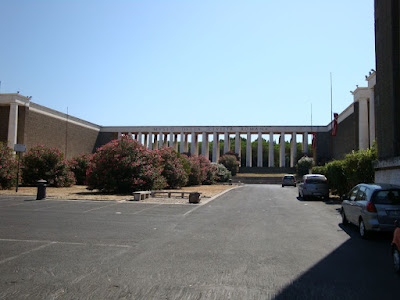



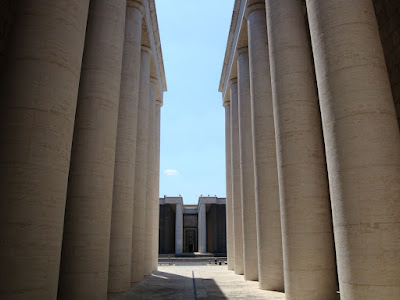

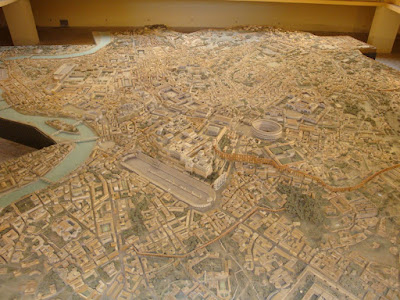
















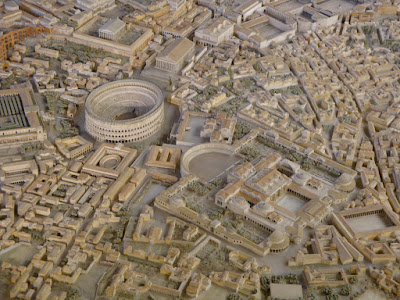






























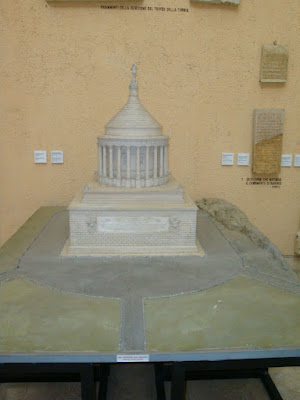



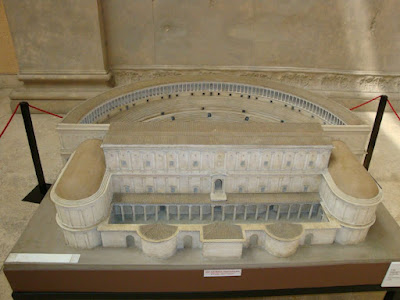

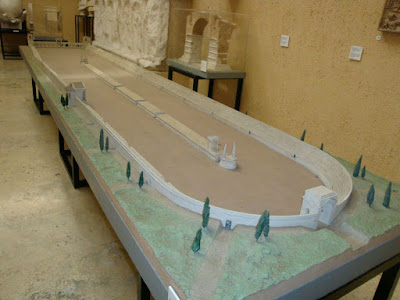










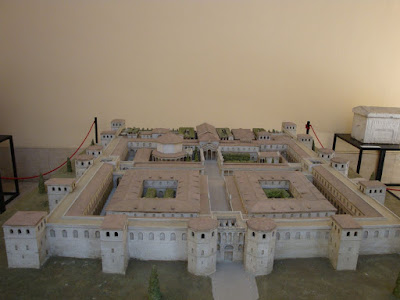





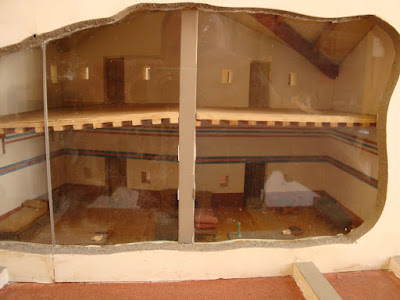





























Keine Kommentare:
Kommentar veröffentlichen